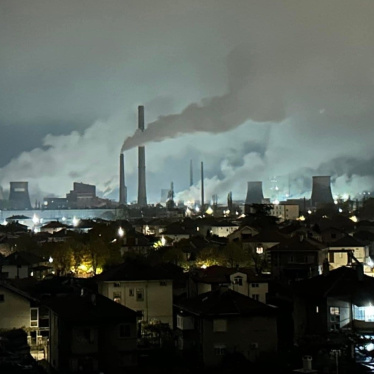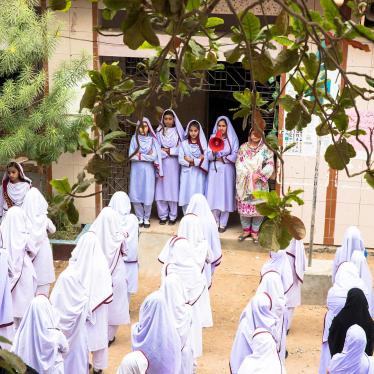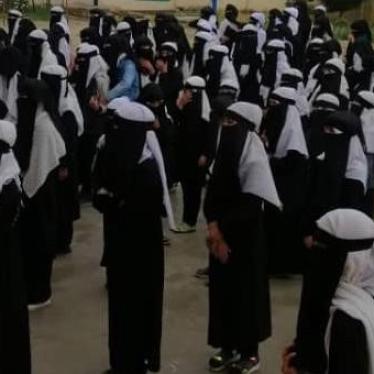Human Rights Watch is concerned about the lack of accurate information on the conflict in South Ossetia and other parts of Georgia, specifically the dramatically different reports on the number of civilians killed and wounded, as well as the number of people displaced by the conflict.
Wounded
Human Rights Watch visited the only field hospital located in North Ossetia, in Russia. The hospital is run by the Russian Ministry of Emergencies and is located near the village of Alagir, where some of the displaced found refuge. A hospital representative told Human Rights Watch that between the time it was established in the morning of August 9 to the evening of August 10, it received 52 wounded, “about 90 percent of whom were military personnel.” According to the representative, almost all of the wounded who end up in the hospitals in North Ossetia go through the field hospital first (the only exceptions are those requiring neurosurgical assistance and those with minor wounds not requiring immediate medical assistance). Most of the 52 were from the city of Tskhinvali, the capital of South Ossetia, and neighboring villages.
The hospital was expecting another 170 wounded (20 of them suffering serious injuries), who were expected to be delivered by ambulances from a mobile military clinic in the South Ossetian village of Java, approximately halfway to Tskhinvali. The hospital representative also said that ambulances could get from Java to North Ossetia unhindered.
Displaced People
Human Rights Watch obtained official figures on the number of displaced persons tallied by the Russian Operative Headquarters for Providing Humanitarian Assistance to the Residents of South Ossetia, located in Vladikavkaz. According to the documents provided to Human Rights Watch by a representative from the headquarters, from August 8 to the afternoon of August 10, the Federal Migration Service registered 24,032 persons who crossed the border from South Ossetia into Russia. However, 11,190 of those went back. The document mentions that “the overall number [of the displaced] was decreasing because of the people who return to join to volunteer militias of South Ossetia.”
The representative also told Human Rights Watch that the figures cannot be considered accurate, as many people cross the border back and forth and thus get registered two or more times. The lists of people with names and places of origin have not been compiled yet. The displaced individuals are currently being accommodated in makeshift dormitories in schools, colleges, kindergartens and other available facilities. In the Alagir area, the authorities also put up a tent camp for the temporary accommodation of displaced people. Several hundred women and children have been transported to summer resorts in Krasnodar and Stavropol in the south of Russia.
Accounts by Displaced Civilians
Human Rights Watch visited a camp for the displaced in the village of Alagir and interviewed more than a dozen individuals, including those from Tskhinvali and neighboring villages. Those from the city reported spending more than three days in the basements of their houses, unable to come out because of the incessant shelling. Two individuals from Tskhinvali – a mother and her pregnant daughter – said their apartment building was severely damaged by shells and they only dared to come out of the basement on the fourth day, early in the morning of August 10, when Russian troops took full control of the city and started transporting local residents to a safe zone. They said the convoy consisted of six buses (about 27 people each), escorted by the military to the safety zone.
Residents of Satikhar village told Human Rights Watch that after the village came under heavy artillery fire on the night of August 7, all women, children and elderly (more than 100 people) started fleeing their homes; most of them spent the next two days hiding in the woods and then trying to make their way toward the Russian border. They were assisted by the Russian military in the village of Ger and transported to North Ossetia.
Many families were separated while fleeing the fighting in South Ossetia, and to date they have not been able to obtain any information as to the fate and whereabouts of their relatives whom they left behind.
One elderly man told Human Rights Watch:
“I’ve never heard such heavy shelling in my life. For the first two days, I was hiding in the basement with my family. Finally, I tried to step outside. As I was outside, a shell hit the roof of the house. I fell to the ground and tried to bury myself under a tree. At that point, another shell hit the ground not far to me – I got my leg hurt by the fragments. I was so scared – I just started running away and left my family behind. Now no one can tell me what happened to my two sons, my daughter, and my two grandchildren. No one knows where they are.”
While all the people interviewed by Human Rights Watch talked about multiple civilian casualties in Tskhinvali and neighboring villages, these reports were based on secondary sources rather than first-hand information




